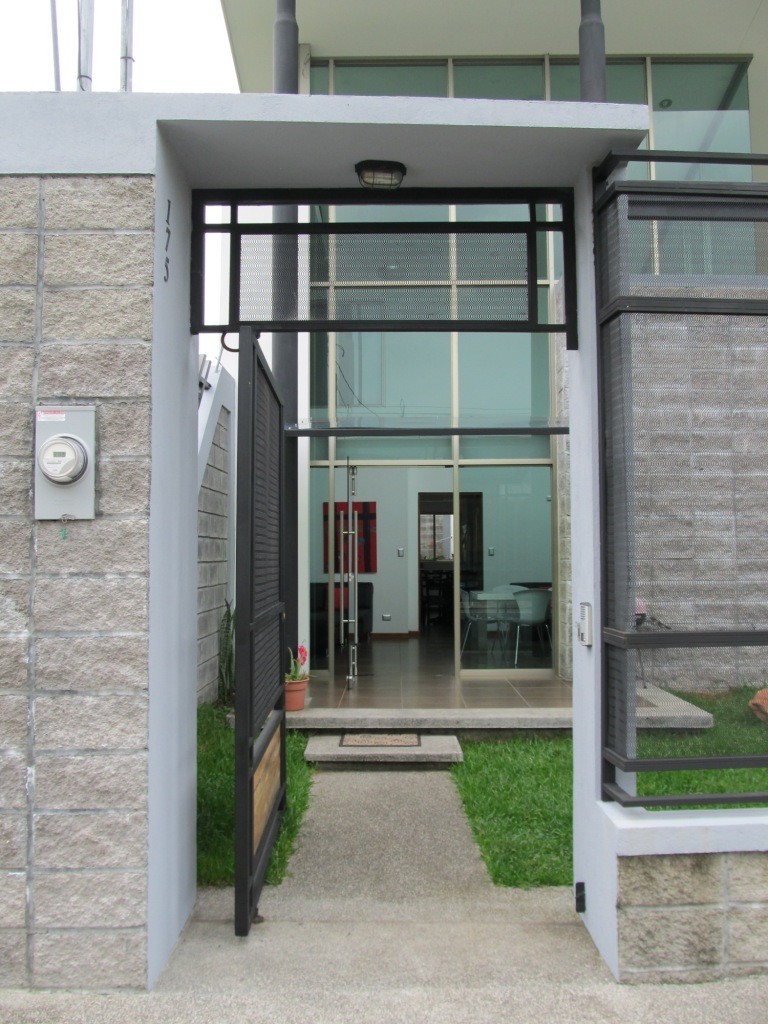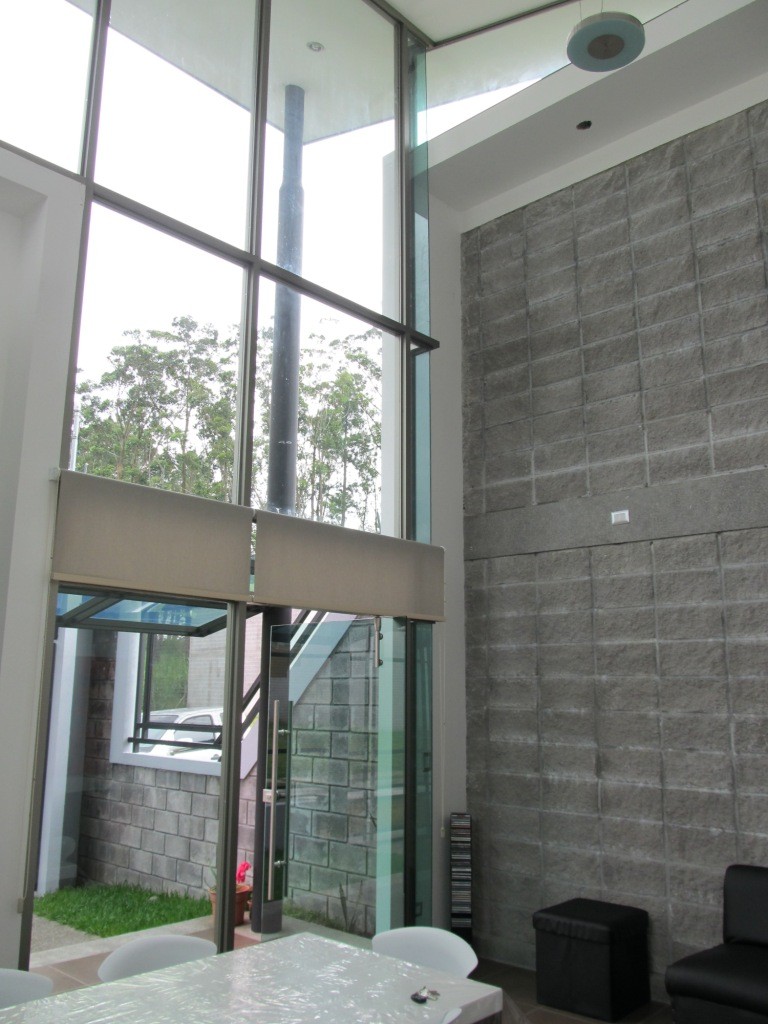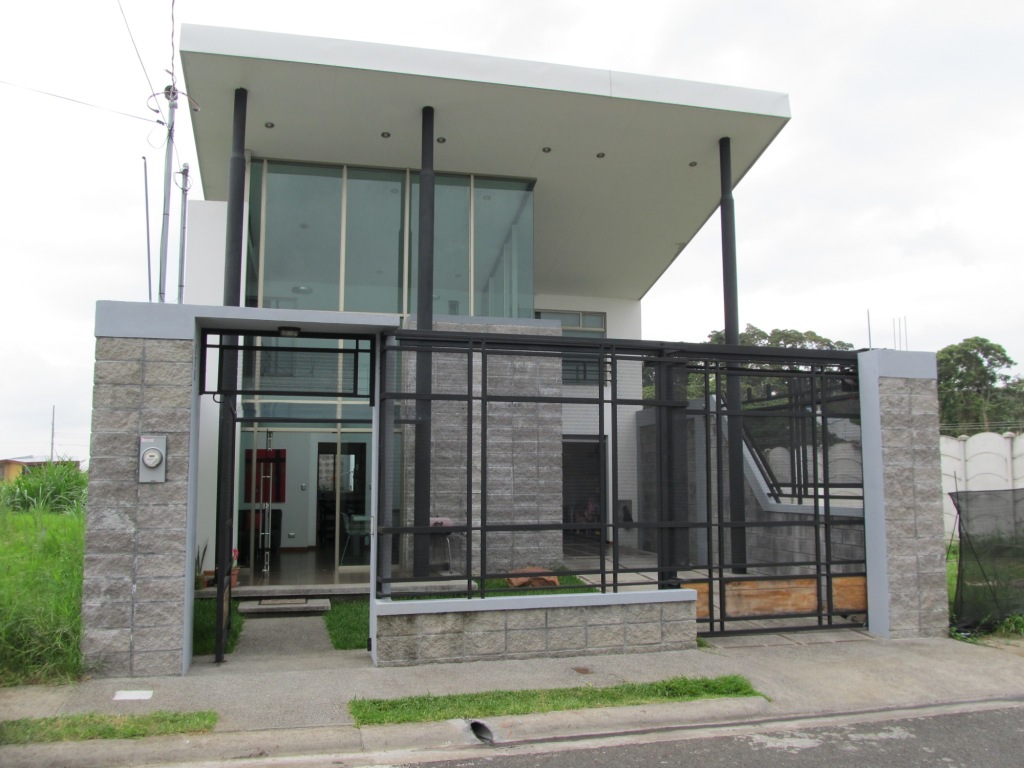Crítica Constructiva
Publicado en Revista «Home Adore»
09 Agosto 2013
https://homeadore.com/2013/08/09/home-3member-family-heredia-costa-rica/
Jonsi Ellis-Calderón, Architect, Head designer
Hallie House is a single family home built in 2010. The piece of land where the project was designed and built is a narrow strip orientated East – West. The main goal was to provide a home for a 3-member family, a couple and a baby girl, within an urban environment in Heredia, Costa Rica. Since the house was to be built in an E-W orientation, taking advantage of the sunlight in the mornings and the afternoons was a must, in order to make the house as bright and clear as possible. This goal was achieved thru large windows in main/east elevation and back elevation; and discrete, non-invading, upper windows in north and south elevations, which are facing both next-door neighbors.
The house has trends of minimalism, with the use of green-tinted glass, concrete, gypsum, exposed blocks and iron mainly. The iron parts are painted all black, and the walls are painted all white, to reduce the need of artificial light during the day, saving energy and money in the long run. The plans of the house have taken into consideration a system that reuses rain water to flush the toilets in the rainy season, six months a year; in the dry season, regular water from the faucet is to be used for flushing. This system might save around 7200 liters of fresh water a year.
The septic tank is not common either; the house has a sustainable treatment system for home, the SerMovil RP-600 bio-digester model, which allows water coming out of the three toilets to be treated safely with no harm to the environment, turning the house ecologically respectful in terms of water treatment.
Even though the project is located in the tropics, there is no need for air conditioning because of natural wind ventilation blowing across the house, thru the use of sliding windows in the back and front elevations.
A mix of concrete/block walls is the main system used. Along with the three round-shaped steel columns, iron for roofing structure and surrounding fence, gypsum for drywalls, green-tinted glass and exposed blocks.

Innovation and Transferability
Harvesting rain water underground for other purposes is not only a very good idea, but also a widely used concept in regions with a very dry weather. However, since Costa Rica has fresh water all year round, people don’t usually take this issue into consideration.
Rain water is not totally potable, so, it’s not good enough for human consumption. However, the use of harvested rain water to flush the toilets during the rainy season is a very simple and useful idea.

Ethical Standards and Social Equity
This house in particular, provides a higher standard to the neighborhood. It is located in a middle class, semi-gated neighborhood, and because of its modern yet simple design, the surroundings have gained value, in terms of security and living standards.
All the stakeholders involved in this project were given space for opinion. Among others, the architect and project manager, electrical engineer, the owner and his family, builder/contractor, local government, local power company and local water system administrator.
Working conditions of laborers were beyond minimum requirements, as it is a must according to costarican labor laws.

Environmental Quality and Resource Efficiency
This house, even though it might be considered a small construction project, features a few good ideas in terms of sustainability. First of all, the interior design of main spaces in the house was meant to take advantage of natural sun light, therefore, saving energy and money over the years. Thus, most, if not all, walls are painted white, a so is the ceiling. Along with this, the house has large windows in East and West elevations, and small and discreet windows in North and South elevations. Therefore, the interiors of the house become very bright and there is no need for electric artificial light during the day.
A water treatment system for homes was installed in order to properly treat water coming out of the three toilets of the house. The model RP-600 designed by SerMovil was used to turn the house environmentally non-impacting and eco-friendly.
The plans of the house also took into consideration an underground concrete tank to harvest rain water during the rainy season. This harvested water was to be used for flushing the toilets, saving some potable water during six months a year. This feature would save around 7200 liters of fresh water per year.

Economic Performance and Compatibility
Since this project is a private family home, saving money by not renting someone else’s house is a step well taken. The decision to make in most middle class families, weather owning or renting, makes sense if you have a dream of owning your own place.
Bank loans are the most common way to achieve that dream. Truth be told, you still pay somebody else a monthly fee, but deep inside, you save for something that is yours and not other people’s property.
The owner made the decision to use bank’s money to follow that dream, which takes courage.

Contextual and Aesthetic Impact
Since its design phase, all the way through its construction phase, this house was to impact the neighborhood powerfully and with quality. The semi-gated, middle-classed neighborhood was enriched by this new home because of its modern, rather than simple, design.
The smaller the land, the nicer the main elevation has to be. For this matter, the house’s main elevation fulfills expectations, making it clear that the use of natural light was important, along with a modern and classy design.
The front elevation also features three steel, round-shaped columns; they are a symbol of the three members of the family, conceptually represented. And this concept also means that these three family members support and hold the home. In one hand, physically they support the house; and in the other hand, spiritually, they support the family as a team.
The project is also well rated in terms of interior design. Even though internal space is minimalistic, rather than simple, it achieves different goals. First of all, public areas are located downstairs; and the main areas downstairs are living/dining room, kitchen, front/set-back garden and studio, and they all have what it takes to be warm and welcoming.
Private areas are located upstairs, three bedrooms and two bathrooms. Wooden floors, white painted walls and upper windows provide that feeling of shelter, simplicity and security in a basic and minimalistic space.
Read a complete article on-line about this project at HomeAdore site:
Home for a 3-member family in Heredia, Costa Rica.



